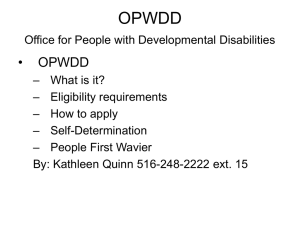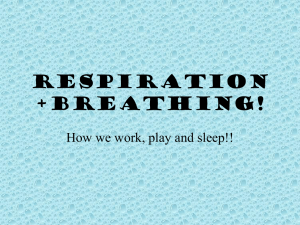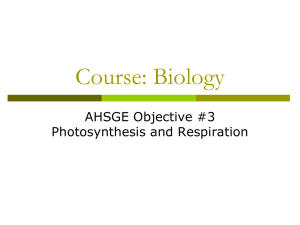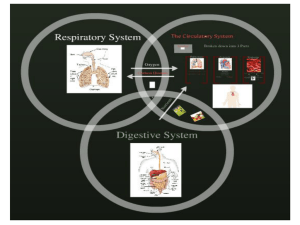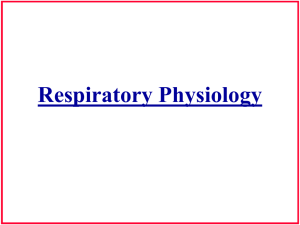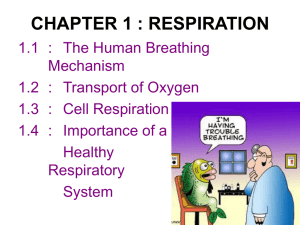Move, Breathe, Succeed
advertisement
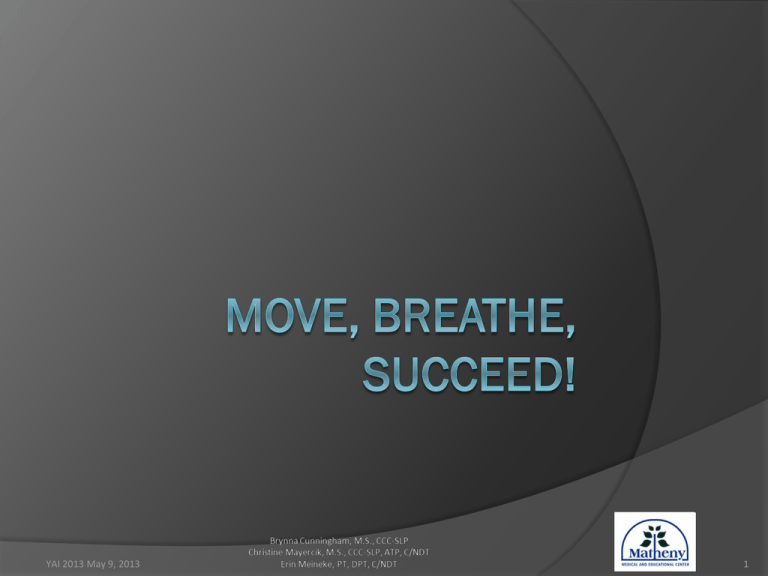
YAI 2013 May 9, 2013 1 Matheny Medical & Educational Center Matheny’s main campus is located in Peapack, NJ. Matheny is home and school to 101 adults and children with developmental disabilities. In addition to their primary diagnoses many children and adults, have a long list of associated clinical conditions such as vision and hearing deficits, seizure disorders, cognitive impairments and dysphagia, with resulting aspiration problems. YAI 2013 May 9, 2013 2 About Matheny Middle States accredited school JCAHO and CARF accredited School and Hospital Multidisciplinary team approach YAI 2013 May 9, 2013 3 Brynna 3 years of experience with the developmentally disabled population Speech Pathologist at Matheny Medical and Educational Center Certifications and Licensure New Jersey State Speech Language Pathologist New Jersey Board of Education Speech Language Specialist American Speech Language Hearing Association Certificate of Clinical Competence YAI 2013 May 9, 2013 4 Christine 11 years of experience with the developmentally disabled population Senior Speech Pathologist at Matheny Medical and Educational Center Certifications and Licensure New Jersey State Speech Language Pathologist New Jersey Board of Education Speech Language Specialist American Speech Language Hearing Association Certificate of Clinical Competence Rehab Engineering Society of North America certified Assistive Technology Professional Certified Pediatric Neuro-Developmental Treatment therapist PROMPT trained YAI 2013 May 9, 2013 5 Erin 10 years of experience with the developmentally disabled population Physical Therapist at Matheny Medical and Educational Center Certifications and Licensure New Jersey State Physical Therapist New Jersey Board of Education School Physical Therapist Certified Pediatric Neuro-Developmental Treatment therapist YAI 2013 May 9, 2013 6 The Rule for Today Every time you hear the word ‘movement’, stand all the way up, then sit down. YAI 2013 May 9, 2013 7 Why is respiration important The process of Respiration: The function of respiration: Diaphragm contracts & Getting oxygen to the moves down Ribcage expands in 3 directions as lungs fill with air Diaphragm relaxes, the ribcage contracts, expelling air from the lungs tissues and organs of the body Removes carbon dioxide/waste YAI 2013 May 9, 2013 8 How respiration is important in daily functioning YAI 2013 May 9, 2013 Gives endurance Feeds brain cells Promotes better health Promotes improved attention Necessary for everything! 9 The Basics-Anatomy of the ribcage Structure Cage like part of the Protect the internal body comprised of bones, muscles and cartilage YAI 2013 May 9, 2013 Function organs such as lungs, heart, kidneys, liver Additionally, it supports the head, neck and upper extremities Brynna Cunningham, M.S., CCC-SLP Christine Mayercik, M.S., CCC-SLP, ATP, C/NDT Erin Meineke, PT, DPT, C/NDT 10 Structure-Bones • Bones – – – – – 12 pairs of ribs, with origin at the thoracic vertebrae and insertion at the sternum. Ribs 1-7 are known as “True” Ribs, meaning they have individual origins and insertions Ribs 8-10 are known as “False” Ribs, meaning they have unique origins on the vertebrae, but articulate with rib #7 at the sternum Ribs 11 and 12 are known as “Floaters”…they have origins on the vertebrae, but do not connect to the sternum. The sternum is comprised of three parts…the manubrium, the body and the xyphoid process. Ribs attach to the manubrium and the body, but not to the xyphoid process. YAI 2013 May 9, 2013 11 Structure-Muscles and Cartilage • • • • • Muscles and cartilage Intercostals…in the space between ribs. On inhalation, the intercostals contract, lifting the ribcage up and out. Sternocleidomastoid, Scalenes, Pectoralis…assist in respiration by lifting the ribcage. Diaphragm…forms the base of the rib cage. On inhalation it flattens and contracts, pulling the lungs down and allowing them to fill. Cartilage connects the true ribs to the sternum. It allows movement of the ribs during inhalation and exhalation. YAI 2013 May 9, 2013 12 The Diaphragm The muscle that forms the floor of the ribcage. Maximizes inhalation Contributes to postural control Supports gastrointestinal function Aids venous return YAI 2013 May 9, 2013 13 Movement of the Ribcage Typical During respiration, the ribcage moves in 3 planes: ○ Up/down (vertical) ○ Front/Back (anterior/posterior) ○ Around (Transverse) YAI 2013 May 9, 2013 14 Movement Break! YAI 2013 May 9, 2013 15 Normal rib cage development • Infant ribcage: – Triangle shape – Whole cage is elevated and ribs are horizontal – High respiratory rate and low tidal volume – Diaphragmatic nose breather Massery, M. 1994 YAI 2013 May 9, 2013 16 Normal ribcage development • 3-6 months – anterior chest wall significantly opens – Ribcage configuration begins to look more rectangular – Respiratory rate decreases as tidal volume increases 6-12 months Child is now upright against gravity Breathing is no longer posturally inhibited by contact with supporting surface Gravity and developing abdominal muscles rotate the ribs and begin to pull them downward which results in an elongated chest wall 12 months + Downward rotation of ribcage continues YAI 2013 May 9, 2013 17 Typical Breathing Patterns Normal Breathing Patterns Clavicular Thoracic Diaphragmatic YAI 2013 May 9, 2013 18 Typical Breathing-Toddler YAI 2013 May 9, 2013 19 Typical Breathing- 5 year old Bench sitting YAI 2013 May 9, 2013 Supine 20 The Basics- Atypical development How we end up with kids who are not breathing well YAI 2013 May 9, 2013 Muscle tone Neurological impairment Physical abnormalities 21 Atypical Ribcage Development Effect on Respiration: Open mouth positioning Increase thoracic kyphosis (flexion) and lumbar flexion Decreased oral motor control – baby is unable to bring hands to mouth Scoliosis Increased thoracic kyphosis Poor Control of Shoulders and Upper Extremities Poor Control of Pelvis and Lower Extremities – due to low tone Rib flaring Poor rib cage and intercostal movement – the rib cage moves as a whole unit to produce body movement, movement occurs between T12-L1 spinal segment Increased thoracic flexion in sitting What we see: Decreased head and neck control Poor Control of Pelvis and Lower Extremities – due to high tone YAI 2013 May 9, 2013 Decreased use of abdominal obliques, which become elongated and weak Increase in thoracic and lumbar flexion Fixing with rectus abdominis which can contribute to rib flaring 22 Atypical Breathing Patterns YAI 2013 May 9, 2013 Paradoxical Diaphragm and upper accessory muscles Upper accessory muscles Asymmetrical Lateral or gravity eliminated Shallow Rib Flare Non-rhythmical breathing 23 Atypical Breathing Patterns Rib Flaring YAI 2013 May 9, 2013 Minimal ribcage movement S/P Spinal stabilization 24 Other Factors Impacting Respiration Posture Position GERD Asthma Genetic conditions Vents, trachs, intubation Scoliosis Spinal Stabilization Other surgeries YAI 2013 May 9, 2013 25 The effects of Posture • A chronically slumped posture can lead to kyphotic posture – Shortened anterior ribcage – – – – wall, shortened rectus abdominus, Forward head position Shoulders are elevated and adducted(protracted scapula and internally rotated humerous) Accessory muscles are not available to aid in respiration Posterior pelvic tilt YAI 2013 May 9, 2013 26 The effects of positioning Sitting positioning Slumped posture Head position Lateral leaning Pelvic tilt Visual issues Body awareness Lacking the ability or understanding to reposition themselves YAI 2013 May 9, 2013 27 Improved respiration=Improved health Respiratory problems are some of the sequela of neurological diagnoses, causing excessive loss of work or school days and numerous hospitalizations Maintaining a healthy respiratory status should be a top priority for a neurologic population. Massery, M., 1994 Massery, M., 1994 YAI 2013 May 9, 2013 28 How to improve respiration Introduce movement YAI 2013 May 9, 2013 Setting up the classroom/or day 29 There is some evidence that physical exercise improves mental sharpness “What’s happening in the body is their heart rate is increasing and blow flow is changing, and they’re actually activating the brain differently than when they are sitting down” ○ YAI 2013 May 9, 2013 John Ratey, Harvard University 30 Support for Movement Breaks “In 2008, the U.S., Dept of Health and Human Services issued physical guidelines for Americans ages 6 and older. These guidelines recommend that children and adolescents participate in 1 hour or more of physical activity daily. Physical Activity should take place throughout the day to meet this recommendation.” “Physical activity improves general circulation, increases blood flow to the brain, and raises levels of norepinepherine and endorphins-all of which may reduce stress, improve mood, induce a calming effect after exercise, and perhaps as a result improve achievement.” Taras, H., 2005 National Association for Sport and Physical Education YAI 2013 May 9, 2013 31 More support According to Betts, et al. (2006), elementary school students’ sustained attention is not fully developed. They suggested that elementary students need breaks during their school day because they cannot stay focused for extended periods of time YAI 2013 May 9, 2013 32 Benefits of Movement Breaks and Respiration Children are often more attentive, behave better, and perform as well or better scholastically after participation in physical activity through recess or physical education. Mahar, M., et al, 2006 Because of budgetary constraints and growing pressure on administrators and teachers to increase academic achievement scores, opportunities for physical activity are being reduced or eliminated. Mahar, M., et al, 2006 YAI 2013 May 9, 2013 33 Movement Break! YAI 2013 May 9, 2013 34 Its easy to make changes Easy, fast, brief Get it into your day with minimal disruption Fun and motivating Make it something everyone can do YAI 2013 May 9, 2013 35 Suggestions of activities Busy City Get Up and Move Over/Under Relay Other resources 10 simple activities to encourage physical activity in the classroom ○ Benefits: Communication Social skills/awareness Sensory/Spatial awareness Creativity Increasing respiration! YAI 2013 May 9, 2013 www.YourTherapySource.com Integrating Physical Activity into the Complete School Day ○ www.naspeinfo.com 36 Ways to introduce movement Pairing movement with respiration Movement breaks in the classroom Alternate positioning Short yoga breaks Incorporating more reaching tasks into lessons YAI 2013 May 9, 2013 37 What we came up with Respiratory boxes: One per classroom A bag for each student Some items are shared by the class YAI 2013 May 9, 2013 38 Respiratory Boxes Some ideas: Have contests to see who can make the loudest noise, longest noise, most attempts at noises, etc. Keep track and see if you can do better than your last attempt. Use the magic mics to participate in short songs: staff sings/speaks a line and allows each student to finish it (any vocalization is acceptable here), kind of like playing karaoke. Let students pick songs out of a hat by reaching to the sides or diagonally to get to the hat. YAI 2013 May 9, 2013 Bubbles: See how many bubbles you can blow initially. Have contests to see who can blow the most, biggest, etc. Try to blow more at the end of respiratory play. Between the first attempt and last attempt, have students help by dipping the wand, grabbing paper towels to dry hands, etc. Have students reach in every direction (up, down, across body, out to the sides, etc), especially laterally. Pinwheels: See who can get theirs going fastest, longest, or most often. Between first attempt and last attempt, have students pass the pinwheels around the circle by reaching laterally to their friends. Play games where one person starts, and when they stop, the next person starts. 39 Video of 301 YAI 2013 May 9, 2013 40 Your turn! YAI 2013 May 9, 2013 41 Questions YAI 2013 May 9, 2013 42 References Aubrey, A. Deskercise: Staying Jazzed and Focused at School. 2009. www.npr.org/templates/story/story.php?storyID=101149470 Bly, L. (2011). Components of Typical and Atypical Motor Development. Laguna Beach, CA: NeuroDevelopmental Treatment Association, Inc. Bachman, J.E. and Fuqua, R.N. Management of Inappropriate Behaviors of Trainable Mentally Impaired Students using antecedent exercise. Journal of Applied Behavioral Analysis, vol. 16, No. 4, pp. 447-484, 1983. Dwyer, T., Sallis, J.F., Blizzard, L., Lazarus, R. and Dean, K. Relation of Academic Performance to Physical Activity and Fitness in Children. Pediatric Exercise Science, Vol. 13, pp.225-237, 2001. Eddy, M. Movement in the Classroom. www.wellnessCKE.net. Move for Health of Body and Mind. Kerby, A. Effects of Breaks on Elementary Students’ classroom Behaviors (master’s thesis). St. Mary’s College of Maryland. Mahar, M.T., Murphy, S.K., Rowe, D.A. , Golden, J., Shields, A.T. and Thomas, D.R. Effects of a Classroom-Based Program on Physical Activity and On-Task Behavior. Med. Sci. Sports Exerc. Vol. 38, No.12, pp. 2086-2094, 2006. Massery M. Multisystem clinical implications of impaired breathing mechanics and postural control. In: Frownfelter D, Dean E, eds. Cardiovascular and Pulmonary Physical Therapy: Evidence to Practice. 5 ed. St. Louis, MO: Elsevier-Mosby; 2012:633-653. YAI 2013 May 9, 2013 43 References Massery M. Asthma: Multi-System Implications. In: Campbell S, Palisano R, Orlin M, eds. Physical Therapy for Children. 4 ed. St. Louis, MO: Elsevier; 2012:815-844. Massery, M., Breathing and Upright Posture: Simultaneous Needs, in 26th International Seating Symposium, Vancouver, BC. March 11-13, 2010;25-28. Massery M. The patient with multi-system impairments affecting breathing mechanics and motor control. In: Frownfelter D, Dean E, eds. Cardiovascular and Pulmonary Physical Therapy Evidence and Practice, ed. 4. St. Louis, MO.: Mosby & Elsevier Health Sciences; 2006:Chapter 39:695-717. Massery MP. What’s positioning got to do with it? Neurology Report. 1994;18(3):11-14. Schroeder, R. Importance of Respiration. www.ehow.com/about_5390615_importance-respiration.html Taras, H. Physical Activity and Student Performance at School. Journal of School Health, Vol. 75, No. 6, pp. 214-218, 2005. Winslow, K.C. Movement Activities for the Classroom. www.ehow.com/print/info_7871679_movement-activities-classroom.html Integrating Physical Activity Into the Complete School Day. www.naspeinfo.org 10 Simple Activities to Encourage Physical Activity in the Classroom. 2001. www.therapysource.com YAI 2013 May 9, 2013 44
